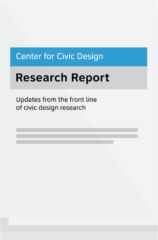How to display results for multi-winner ranked choice voting elections
This research explored how to best present election results for multi-winner ranked choice voting (RCV). We tested 2 sets of multi-winner result displays: a summary table and bar charts. The findings showed that people find bar charts especially helpful for understanding how votes shift across rounds, while detailed tables build trust and transparency by showing the full tabulation process.

How to display results for multi-winner ranked choice voting elections
Download report (PDF)Key findings
People find data displayed in bar charts easy to understand.
The visuals of a bar graph allows voters to more easily and quickly understand how the votes “moved” in each round. People found it easier to compare and contrast how candidates fared against each other in each round.
Detailed information sources promote trust and transparency for voters.
Voters like having access to a table that displays all the rounds of tabulation. When voters have the ability to look at the “raw data,” it can lead to greater trust in the tabulation process.
Voters desire ways to easily compare and contrast final votes among candidates.
Voters are curious to know who the “most popular” candidate is. Despite multiple people being elected to a position, voters want to see how winning candidates compared against each other in easily understandable numerical terms.
Voters want to understand quickly and easily what is happening in each round of tabulation.
These numbers overwhelmed voters. Some participants scanned the page, somewhat understood tabulation rounds, and moved on. Other participants saw the page and barely examined the content.
About the research
This research was conducted by Isabelle Yisak.
We conducted in-person usability testing with prototypes. We asked 19 participants to interact with 2 sets of results displays and to share analogies that help explain multi-winner RCV. We pulled the data for both results displays from Minneapolis’s 2021 multi-winner RCV contest for the Park and Recreation Commissioner At Large.
Participants joined sessions held at Holgate Public Library, which lies on the border between voting District 1 and District 3 in Portland, OR.
Related resources
Visit our page on ranked choice voting to find best practices for designing ballots, voter education, and election results for ranked choice.

